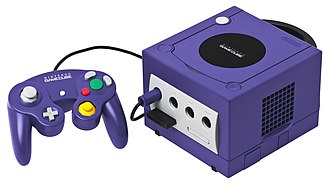GameCube
| File:Nintendo Gamecube Logo.svg | |
 An indigo GameCube console with its controller and the 251-block memory card | |
| Also known as | Dolphin (code name) |
|---|---|
| Developer | Nintendo |
| Manufacturer |
|
| Type | Home video game console |
| Generation | Sixth generation |
| Release date | Template:Vgrelease |
| Retail availability | 2001–2007 |
| Discontinued | Template:Vgrelease |
| Units sold | |
| Media |
|
| Operating system | Dolphin OS |
| CPU | IBM PowerPC Gekko @ 486 MHz |
| Storage | None |
| Removable storage | GameCube memory card (16 MB max. capacity) |
| Display |
|
| Graphics | ATI Flipper @ 162 MHz |
| Sound | Analog stereo (Dolby Pro Logic II) |
| Controller input | GameCube controller, WaveBird, Game Boy Advance, various other input devices |
| Connectivity | GameCube online functionality |
| Online services | Limited |
| Dimensions |
5.9 × 6.3 × 4.3 in 149 × 160 × 112 mm (width × depth × height) |
| Best-selling game | Super Smash Bros. Melee, 7.09 million (Template:As of)<ref>Template:Cite press release</ref> |
| Predecessor | Nintendo 64 |
| Successor | Wii |
| Related articles | Panasonic Q |
Introduction
The GameCubeTemplate:Efn is a home video game console released by Nintendo in Japan and North America in 2001 and Europe and Australia in 2002. The sixth generation console is the successor to the Nintendo 64 and competed with Sony's PlayStation 2 and Microsoft's Xbox.
The GameCube is the first Nintendo console to use optical discs as its primary storage medium. The discs are in the miniDVD format and the system was not designed to play full sized DVDs or audio CDs. The console supports online gaming for a small number of games via the broadband or modem adapter and connects to the Game Boy Advance via the link cable, allowing players to access exclusive in-game features using the handheld as a second screen and controller.
Contemporary reception of the GameCube was generally positive. The console was praised for its controller, extensive software library and high-quality games, but was criticized for its exterior design and lack of features. Nintendo sold 21.74 million GameCube units worldwide before it was discontinued in 2007. Its successor, the Wii, some models of which have backward compatibility with most GameCube software, was released in November 2006.